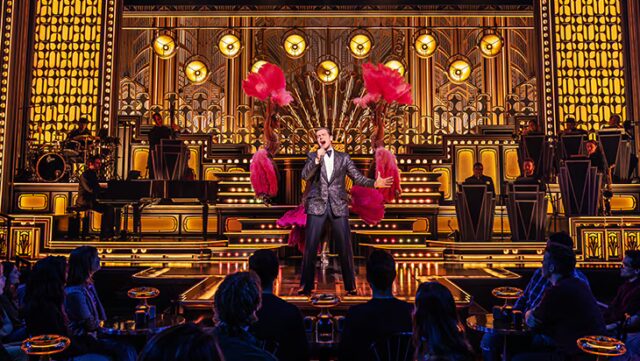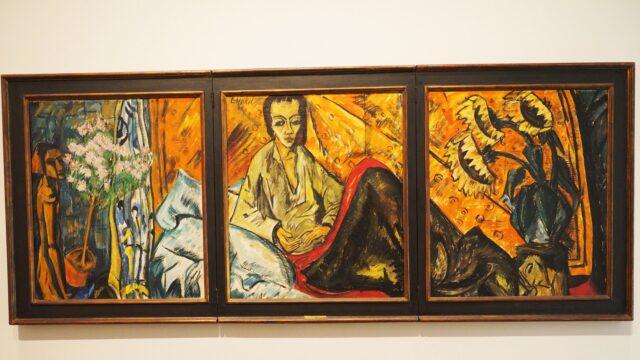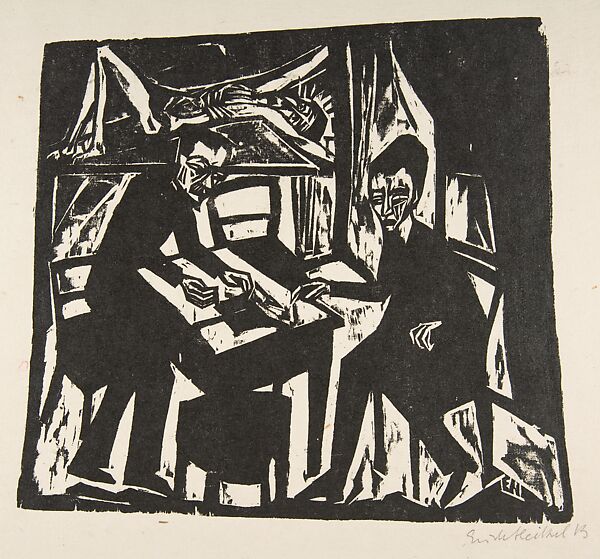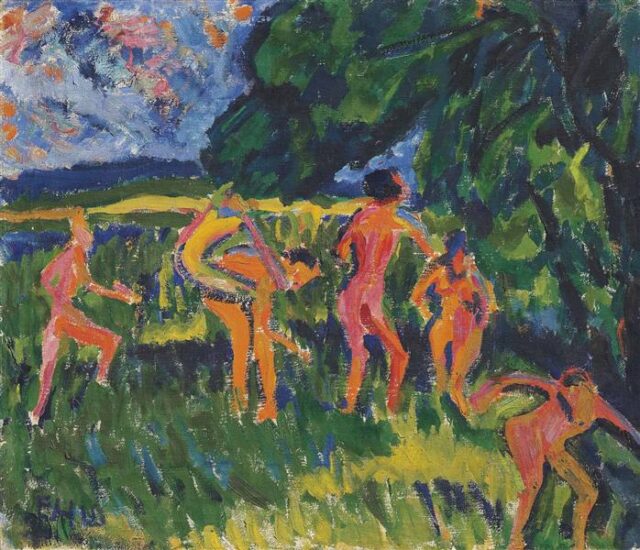
19 Nov TIO NYC: “Just in Time,” A Must, & Neue Gallerie!
“We need joy as we need air…,” Maya Angelou.
A great reason to visit the Neue Gallery and grab a ticket (assuming you are lucky – and persistent) to “Just in Time,” now up at the Circle in the Square (in the basement of the Gershwin Theatre where “Wicked” is playing).
Jonathan Groff & “Just in Time”

Jonathan-Groff. Photo by Matthew Murphy and Evan Zimmerman.
Acting coach Stella Adler famously quipped: “Theatre is life made urgent.”
William Shakespeare weighs in: “All the world’s a stage, and all the men and women merely players,” which draws a parallel between life and performance.
Influential American actor and acting teacher Sanford Meisner adds to the subject: “Life beats down and crushes our souls and theatre reminds us that we are alive!”.
Making Jonathan Groff and his performance in “Just in Time” one sure-fire antidote to this soul-crushing sociopolitical world we are living in today – and a case in the above points.
In this musical drama Groff and his equally brilliant supporting cast take up residence in our consciousness. And that is a very very good thing.
What is it all about?
“Just in Time” is a jukebox-biographical musical about the life and career of the singer Bobby Darin, starring Groff as Darin’s body-and-soul double. It is also a stage experience that evokes the halcyon days of 1950s/early 1960s – and that of Darin, when his claim to fame was in high.relief.

Bobby and San dra Dee, courtesy Just in Time.
Little known fact: Walden Robert Cassotto became Bobby Darin soon after his career took off (when he was still a teen). Cassotto chose the name in white-light moment after spotting a sign on a ManDARIN restaurant, with the first three letters shut down.
From production notes:
“Tony Award® winner Jonathan Groff (“Merrily We Roll Along,” “Hamilton”) is back on Broadway and is “onstage perfection” (Chicago Tribune) as Bobby Darin, the legendary singer whose short but remarkable life took him from teen idol to global sensation.
“Developed and directed by Tony Award winner Alex Timbers (“Moulin Rouge!,” “Beetlejuice”), with a book by Warren Leight and Isaac Oliver, “Just In Time” is an “utterly electrifying” (Entertainment Weekly) new musical that immerses audiences into an intimate nightclub “so seductive in ambiance that you find yourself not wanting to go back outside” (Chicago Tribune).
“Complete with iconic Bobby Darin hits including “Beyond the Sea,” “Mack the Knife,” “Splish Splash,” and “Dream Lover,” Just In Time is “a helluva good time at the theater” (Time Out).
“The production takes place in an immersive nightclub-style staging (at the Circle in the Square Theatre) to evoke the era and show‐business world that Darin inhabited.

Courtesy “Just in Time.”
We are still on a “Just in Time” high and second those hosannas from the critics. No one in the audience – including us to restate the obvious – wanted this sold-out show to end.
As the luminous star of the show Groff is simply following his bliss. He explained to the cheek-by-jowl crowd that “as a child I would twirl in his mother’s heels listening to Darin’s hits.” In other words sports were not his thing. Groff went on to reveal that the only successful relationship Darin had was with his audience. “Ditto.”
As Groff explained to Vogue:
“His voice kept telling me that I had to bring myself first and then tell the story of his life … That is what I’m trying to do: by tapping into myself, I’m tapping into Bobby Darin and honoring the present moment. … Every night, the audience isn’t meant to be extras in a 1959 club show at the Copa … They’re meant to be the audience they are now … and we’re all gonna experience Bobby Darin’s life story together.”
A tip of the hat to Ram Dass and his world-famous trope: Be Here Now.
“Just in Time” is no dusty bio romp, rather it is an energetic, immersive, and intimate nightclub experience sporting maximalist lighting and fully and immersive staging – see above from Ram Dass – a joyous, fun, eye-popping experience, chockablock with great singing and dancing. The production drips with charm.
In addition to the superstar Groff,
An energetic, immersive razzle-dazzle of a must-see.
Go here to. learn more about the rest of the dazzling cast.
Neue Gallerie, featuring Erich Heckel in a charming thumbnail solo show

Founded by Serge Sabarsky, an art dealer and expert in Austrian and German Expressionism, and Ronald S. Lauder, the businessman and philanthropist, the Neue Galerie opened for business in 2001, occupying a landmark 1914 Beaux-Arts mansion at Fifth Avenue and 86th Street, originally designed by Carrère & Hastings for industrialist William Starr Miller.
The venue features fine art from Austria and Germany (1890–1940), including works by Klimt, Schiele, Kokoschka, Beckmann, Kandinsky, and more. The most famous image on display is Gustav Klimt’s “Portrait of Adele Bloch-Bauer I” (1907), often referred to as the “Woman in Gold.” Lauder acquired the world-renowned painting in 2006 for a then-record $135 million, after a historic restitution case by Maria Altmann, Bloch-Bauer’s niece.
What was German Expressionism all about?
The movement, (roughly 1905–1925), sought to express inner feeling over outward reality. Instead of painting the world as it looks, Expressionist artists painted the world as it felt.
German Expressionism breaks down. into two major groups of artist: Die Brücke (The Bridge) – Dresden/Berlin, which showcased emotion, color, rawness, youth, freedom.
And Der Blaue Reiter (The Blue Rider) – Munich (Kandinsky, Franz Marc, etc.) More spiritual, symbolic, often more abstract.
Running from October 9, 2025 through January 12, 2026 the Neue is currently showing a special monographic exhibition: “Erich Heckel”
Although Heckel was an important figure in German Expressionism he has tended to receive less attention than some of his peers. This show helps to redress that imbalance.
“The unsung driving force of Die Brücke… his art was at least as bold and radical… and worthy of more attention,” wrote The Art Newspaper.
Of note:
To the Convalescent Woman, (1912–13). In a quiet and eeply tender painting. Heckel paints illness and recovery not with sentimentality, rather with emotional clarity.Checkout how its background echos the mood of the sick, but recovering woman.

Image, courtesy Neue.
Two Men at a Table, (1913, woodcut), which showcases a psychological drama in a very condensed space.

Image, courtesy Neue.
Early Brücke-period bathers, (c. 1909–1911), featuring pure Die Brücke energy—freedom and instinct.

Bathers-in-the-Reeds-1910.
Wartime drawings and prints, (1915–18). Heckel served behind the front lines in WWI as a medical orderly. so we can feel – pure Expressionist dictum, the war darkening his palette.

Image, courtesy Neue.
Post-war works, (1919–20), which underlines the artist’s evolution from youthful revolt to wartime reflection to post-war introspection.

Image, courtesy Neue.
“Erich Heckel” is a jewel of show in a jewel box of a venue.
While at the Neue you might want. to check out its Café Sabarsky with its dark-wood paneling, elegant furnishings and strong Viennese-coffeehouse ambiance.
We recommend going for dessert – and the ambiance- rather than a full dinner. Though charming, the place is spendy and service can be slow.


No Comments